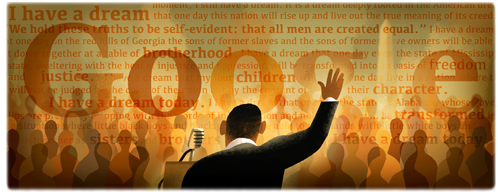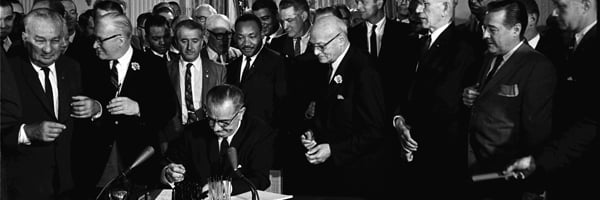March on Washington's 50th Anniversary

Fifty years ago today on August 28th 1963, the largest march for civil rights took place in the nation’s capital attracting some 200,000+ Americans. It was here at this march that Martin Luther King Jr. would deliver his now famous “I Have a Dream” speech, challenging the country to end racial discrimination, particularly against Black Americans. King would give his speech in the foreground of the Lincoln Memorial statue, nearly 100 years after Lincoln’s Emancipation Proclamation.
The March on Washington for Jobs and Freedom was created to address the longstanding racial inequality and discrimination that continued to plague American institutions even after World War II. The activists and leaders who organized the march were predominantly Black, but Americans of various backgrounds attended the rally. Notable Black entertainers at the time would also participate. Sammy Davis Jr, Josephine Baker, Marian Anderson, Ossie Davis, and Ruby Dee to name a few.
The March on Washington was a pinnacle event in the Civil Rights Movement, and is one of the most important and revered civil rights events to take place in America. Martin Luther King’s speech would continue to ring into the 20th century, for it is his most commonly known address about racial inequality in the U.S.
The demonstration that day would call for desegregation, economic rights, worker training, and fair employment.
While there is still work to do in terms of the racial disparity in multiple facets, since the March on Washington, so much has changed. Big changes such as institutional racial segregation and discrimination based on race is outlawed, granting the access to schools, public places, unions, and restaurants to people of all races and ethnic backgrounds. Every American, regardless of race, cannot be denied service or employment based on the color of their skin.

On July 2, 1964, nearly a year after the march, President Lyndon B. Johnson signed into law, the Civil Rights Act of 1964 in the presence of Dr. King and other Black activists. The Civil Rights Act of 1964 also birthed the Equal Employment Opportunity Commission (EEOC), created to enforce key parts of the act. Almost a year afterwards, the Voting Rights Act of 1965 would also pass, protecting minorities from voting discrimination and put to end to discriminatory literacy tests that aimed to bar them from polls. It was this law that finally gave minorities a political voice. The two laws became a milestone in the legislative victories for minorities.
Following the Voting Rights Act, voter registration for Blacks in the South increased. The new provisions finally gave Blacks power to change the racial political atmosphere that controlled the South much after the Civil War. To this day, the Civil Rights Act is the most wide-ranging law supporting racial equality to ever be imposed by Congress.
As we honor the anniversary of the landmark event, we should also remind ourselves of discrimination that still exists, and laws that came afterwards which continue to create a racial disparity among Americans. The most recent example is New York City’s controversial Stop-and-Frisk law, and similar variations of it in other cities. These laws tend to disproportionately target Blacks and Latinos.
Honoring the semi-centennial event, President Obama will give a speech in the same location at the Let Freedom Ring commemoration.
Watch footage and the full ‘I Have a Dream’ speech below:




